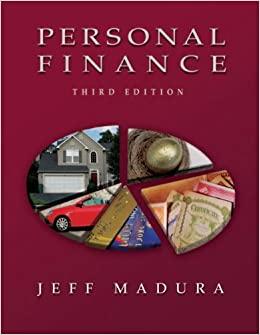
8.10 Exercises 1. If the beta of Amazon.com is 2.2, the risk-free rate is 5.9% and the market risk premium is 8%, what is the expected rate of return for Amazon.com stock? 2. If the required return on Exxon Mobil is 10,5%, the risk-free rate is 4% and the market rate of return is 14%, what value must Exxon's beta take? 3. True or False? If a stock is overpriced it plots above the security market line. 4. Consider the following data for a stock: beta 0.9, risk-free rate 4% market rate of retum - 14%, and expected rate of retum on the stock = 15% Is this stock underpriced, overpriced or fairly priced? 5. You are an investment manager who is running an aggressive UK equity portfolio worth 12m. The portfolio has a beta of 14. You are concerned that the market risk of this position is too large and would prefer it if the beta of your portfolio was closer to 1.25. You can also invest in a FTSE-100 tracker portfolio which has a beta of exactly 10. Explain how you might redistribute the 12m between the aggressive UK portfolio and the FTSE-100 tracker so as to reduce risk to your desired level. 6. Assume that the CAPM holds. The risk-free rate is 3%. A portfolio that is a combination of the risk-free asset and the market portfolio has an expected retum of 12% and a return standard deviation of 18%. The expected return on the market portfolio is 15%. (a) What is the volatility of the market retum? (b) Consider a security X. Its returns have a 0.40 correlation with the returns on the market portfolio and a standard deviation of 36% What is its ? () What rate of return would you expect for X? (d) Comment on the market risk associated with security X MacBook Pro Question 1 Two (default-free) government bonds, A and B, are trading at a current market price of $80 and $74, respectively. Bond A is a zero-coupon bond with 1 year to maturity. Bond Bis a 10% coupon bond with 2 years to maturity. Both bonds fave a face value of $100. Assume any coupons are paid annually. a) Determine the 1-year and 2-year spot rates (2 marks) b) Answer the following: i. What is the Macaulay Duration of Bond B at its yield to maturity? You may find the following formula helpful: the solution to the quadratic equation ax? + bx+c = 0 is given by x = (-b vb2 - 4ac)/2a. (3 marks) il. Using the duration approach, approximate the dollar change in the price of the bond if its yield increases by 1 percentage point. (2 marks) iii. Would the magnitude of this price change be larger or smaller if Bond B was currently selling at par? Explain without the aid of any calculations. (3 marks) c) A third government bond, Bond C, is currently trading for $83. Bond C has a 20% coupon rate, a face value of 100, and matures in 2 years. Is there an arbitrage opportunity at this price? If yes, show how to construct an arbitrage portfolio that delivers a guaranteed positive cash-flow today and zero net cash flows in future years. Assume you can go long or short in all assets. (5 marks) d) 'An upward sloping term structure implies that the market expects future spot rates to increase.' Discuss this statement in relation to theories of the term structure of (5 marks) interest rates








